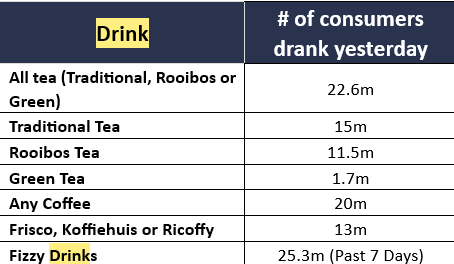When it comes to hot beverages, different demographic groups in South Africa tend to choose between coffee and various types of tea, including Rooibos.
What do South Africans like to drink when they take a break? Some of us cannot do without the early morning pick-me-up coffee, but other drink only tea. And if they drink only tea, which kind of tea do they prefer?
Eighty20 spills the tea on what South Africans like to sip by looking at the data. Andrew Fulton, director at Eighty20, says while coffee may be the go-to morning pick-me-up for many, tea remains the true global favourite, second only to water as the most consumed beverage in the world according to the International Institute for Sustainable Development (IISD).
“In South Africa, it is common to ask if people want Rooibos or regular when offering a cup of tea, and this shows how popular Rooibos is. Grown exclusively in the Cederberg region of the Western Cape, this naturally caffeine-free tea has become a global favourite. Just like Champagne, only products from this region can proudly carry the Rooibos name.”
The data shows that over 22.6 million South African adults enjoy Rooibos, green tea or traditional tea every day. And they do not only stick to just one type of tea, Fulton says. Almost 30% of traditional tea drinkers also sip some Rooibos daily, and almost half of them pair their tea habits with a daily cup of coffee.
Fulton says for brands this is a clear signal that tea time is all the time and for grocers, it is also important to look at complementary products, such as sugar. South Africans consume on average 4.2 teaspoons of sugar in tea, coffee, beverages or cereal per day.
ALSO READ: Why experts recommend Rooibos for better health
Who drinks what when it comes to coffee, tea and Rooibos tea?
Coloured and Afrikaans-speaking people in the Western Cape and Free State consume considerably more, while isiXhosa and isiZulu speakers in the Eastern Cape and KZN consume considerably less. This table shows what South African consumers drank yesterday and how many chose tea or coffee.
ALSO READ: Five tips to make the best cup of tea
Where tea comes from
When it comes to traditional tea, China is in the lead, producing nearly half of the world’s tea, followed by India, Kenya and Sri Lanka (formerly known as Ceylon until 1972, a term still used interchangeably in South Africa for traditional tea).
Fulton points out that tea is a massive industry, with global production valued at $17 billion, while the industry employs approximately 13 million people worldwide.
Kenya is famous for its high-quality black tea, with its tea sector contributing over a quarter of the country’s annual export earnings and providing employment to nearly 2 million people. South Africa’s tea market is also brewing strong, projected to hit $447.29 million in revenue by 2025 with a steady annual growth of 3.07%.
Joko tea and Glen tea are the market leaders for traditional teas in South Africa, while Freshpak remains the top pick for over half of all Rooibos drinkers.
ALSO READ: 10 surprising facts about Rooibos
More people are drinking tea
Fulton says the consumption of traditional tea is increasing in East Asia, Africa and Latin America, but declining in Europe and North America. In North America, herbal teas and other ready-to-drink beverages are becoming more popular.
“This trend also positively affects our local tea substitute, Rooibos. The global Rooibos tea market is estimated to be worth approximately $1.3 billion in 2023, thanks to Rooibos Limited, the largest producer and distributor of Rooibos tea, exporting to 50 countries worldwide.
What is the difference between traditional tea and Rooibos? Traditional teas like black, green and Oolong all come from the Camellia sinensis plant, but Rooibos tea is different. It is technically not a true tea but a tisane, a caffeine-free herbal infusion made by steeping plant materials in hot water.
According to Fulton, people are switching to Rooibos all over the world, not only because it is a delightful drink but also due to its numerous health benefits. “This naturally caffeine-free beverage is rich in antioxidants, helps to reduce blood pressure and improves cholesterol levels, soothes an aching stomach and can help to clear your skin.”
ALSO READ: Rooibos industry paid R12 million to Khoi and San community in historic move
What the data shows about tea drinkers
There is also tea drinking demographics that show how much people all over the world love a cuppa. Using data from MAPS, a survey of 20 000 South Africans conducted by the MRF, Eighty20 a consumer analytics and data science agency, shows that women, Indians and Asians are over-indexed for all types of tea.
The data also shows that Rooibos tea drinkers have marginally higher personal and household incomes than people who drink traditional tea, but the average household income of people who prefer green tea is nearly twice that of other tea drinkers. Green tea drinkers are also younger and better educated.
Fulton says looking at the Eighty20 National Segmentation groups, poorer segments, such as the Humble Elders and Mothers of the Nation, tend to drink traditional tea, while Comfortable Retirees prefer Rooibos tea and the Heavy Hitters and Middle Class opt for green tea. This table shows the preferences of the different groups:
“Tea remains a cultural staple and commercial powerhouse in South Africa, with over 22 million adults drinking it daily. The growth of Rooibos tea locally and globally signals a shift in consumer preferences towards healthier, caffeine-free alternatives, offering valuable opportunities for brands looking to connect with evolving lifestyles and demographics,” Fulton says.
NOW READ: Is coffee a luxury? Jacobs Coffee explains the price increase
